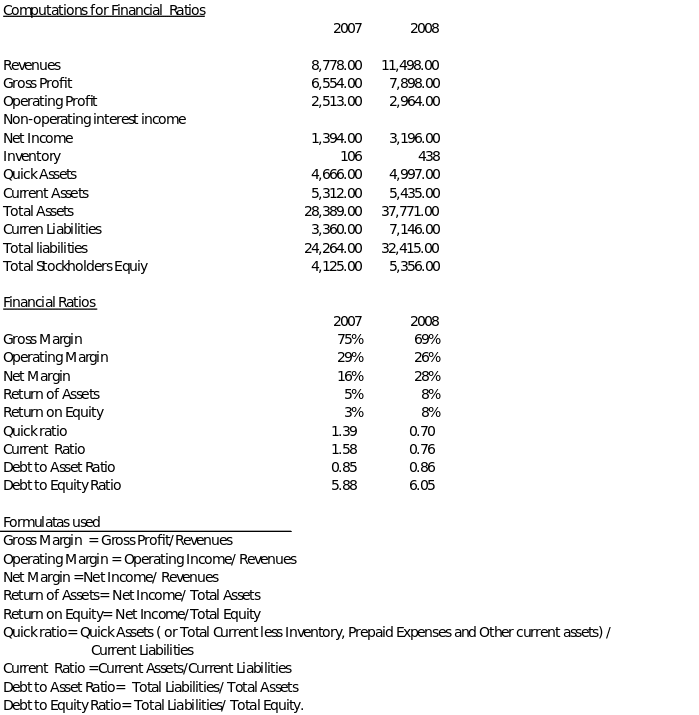Introduction
National Grid plc (or National Grid) owns and operates regulated electricity and infrastructure networks in the United Kingdom and the United States with related interests in related markets such electricity interconnectors, metering devices, liquefied natural gas (LNG) facilities, and property in the UK, LNG storage and transportation, unregulated gas transmission pipelines and home energy services in the United States. It operates under different segments which include Transmission-UK, Transmission-US, Gas Distribution Company sold its UK and US wireless infrastructure operations respectively. In August 2007, the company sold its Basslink electricity interconnector in Australia and completed its acquisition of Key Span Corporation (MSN, 2009; New York Times, 2009).
This paper conducts an analysis of financial performance, liquidity position, and future prospects of National Grid for the years 2007 and 2008 by using relevant ratios. This also discusses the reliability of financial statements of using materials from the Annual Report of National Grid.
Analysis and Discussion
Analysis of Performance (45%)
This part gives an overview of National Grid’s results of operation for the year 2008 compared with 2007 using appropriate ratios. This will identify and discuss exceptional items, continuing and discontinued operations, and acquisitions for 2008 and 2007. This will include discussing and understanding the nature of exceptional items, the reasons, and wisdom of discontinued operations, making acquisitions, and undertaking any other reorganization. This will further calculate and comment on the profit sustainability by the
company as well as discuss the quality of profit that will be revealed by segment analysis.
The effect of exceptional items
The company’s management claims to have made presentations of certain items in the financial statements with the aim of better understanding of the information. It excluded that exceptional items, remeasurements, stranded cost recoveries, and amortization of acquisition-related intangibles from the measures of business performance of used by management to monitor financial performance as they are considered to distort the comparability of reported financial statements from year to years.
It referred to measures of business performance in its Annual Report and Accounts as adjusted profit measure in order for National Grid to clearly distinguish the same from comparable total profit measures. The company’s presentation therefore made different adjusted operating profit, adjusted profit before tax, adjusted earnings and adjusted earnings per share from total operating profit, profit before tax, and profit for the year attributable to equity shareholders, and earnings per share respectively by the exclusion of exceptional items, remeasurements, stranded cost recoveries and amortization of acquisition-related intangibles.
Exceptional items as designated by management include significant restructurings, write-downs or impairments of non-current assets, significant changes in environmental or decommissioning provisions, integration of acquired business and gains or losses on disposals of businesses or investments. To see the impact of exceptional items is to compare whether the said exceptional items have increased the bottom line net profit. The impact of the exceptional items on the reported results revealed that the same has actually reduced the total profit by as much as £242 million in 2008 and £22 million in 2007 as shown in the table below.
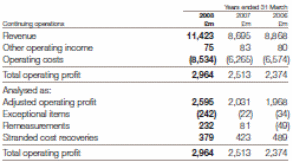
The effect of any discontinued operations, acquisitions, or any other reorganizations of the company during the year
For the purpose of this paper discontinued operations in the case of National Grid refers to those components of the company that either has been classified as disposed of or is classified as held for sale. The company asserted that its discontinued operations at March 31, 2008 consisted of the Ravenswood generation, Key Span Communications and Key Span Engineering Associates, all of which National Grid acquired on August 2007 and which the company classified as business held for sale.
During 2007/2008, its discontinued operations also included its wireless infrastructure operations in the UK, the US and the electricity interconnector in Australia that the company all sold in 2007. In March 2008, National Grid decided to sell the Ravenswood generation station for $ 2.9 billion (£1.4 billion) and from these transactions the company got its hefty gain from sale. Since the sale is subject to approval from the various regulatory bodies and completion expected by summer 2008, the sale may considered as not yet final but the effects on net income were already evident and should be considered to purposes of analysis.
The comparative effects of discontinued operations on the company’s profits could be best appreciated from the information in Table B below.
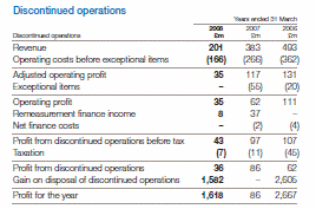
It appears that the great part from the increase in profits for 2008 and 2006 as shown above comes from gain on sale of discontinued operations for £1,582 million and £2,606 million respectively. Its gain on disposal of discontinued operations in 2005 and 2006 relates to the sales of gas distribution networks. The company’s earnings per share from discontinued operations in 2007/2008 was reported to 62.0 pence per share, which includes 60.6 pence per share relating to gains on the business sold during the year, compared with 32 pence per share in 2006/2007.
It must be noted that a portion of 2006 information is included in the analysis for better understanding of the effects on 2007 and 2008 which are the primary years for comparison and as way to show the lack of regularity of those affecting discontinued operations of the company. It is therefore evident that 2008 was far better than 2007 in terms of discontinued operation. This could be further supported by that net profit from continuing and discontinued operations was £ 3,199 million in 2007/2008, as against £1,396 million in 2006/2007. When translated into total earnings per share from both continuing and discontinued operations, the same would mean 122.5 pence per share in 2007/2008 as against 51.3 pence per share in 2006/2007.
The contributions made by each significant segment of the company. (45%)
The contributions made by each significant segment of the company are as follows:
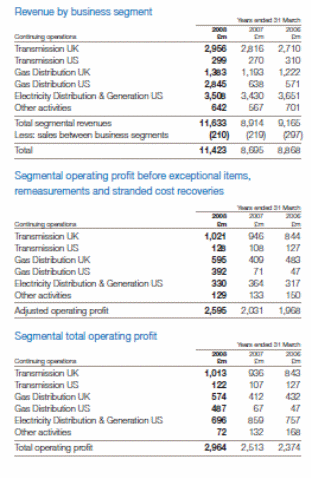
It appears that that each segment is contributing to the profitability of the company as a whole before and after, exceptional items, remeasurements and stranded cost recoveries.
Transmission UK segment contributes the highest profit among all segments before and after exceptional items, remeasurements, and stranded cost recoveries. In terms of segmental total operating profit after exceptional items, remeasurements and stranded cost recoveries, Electricity Distribution and Generation US comes after Transmission UK, which comes as third and Transmission US and comes as fourth.
The above results however vary in terms of segmental profit before exceptional items, remeasurements and stranded cost recoveries since what came second was Gas Distribution UL, followed by Gas Distribution US and Electricity Distribution and Generation came fourth. This means there are segmental profits attributed to exceptional items, remeasurements and stranded cost recoveries allotted to Electricity Distribution and Generation US than Gas Distribution UK and Gas Distribution UK.
It is very clear from the data that in terms of transmission and Gas distribution, both segments from UK have provided higher profits than those from the US. This is despite the fact that Gas Distribution US has higher revenues than Gas Distribution UK.
Analysis of Liquidity (10%)
This part will discuss the liquidity, working capital and long term capital position of the National Grid, using relevant ratios. This will further analyze the cash flow statement for the years and 2007 as well as assess the risk of corporate failure based on liquidity ratios. Liquidity simply means capacity to meet a company’s currently maturing obligations. It is measured using the current ratio and the quick asset ratio (Bernstein, 1993; Brigham & Houston, 2002).
To get current ratio just divide current assets by current liabilities while quick assets ratio is almost the same except that the inventory and prepaid expenses are being removed from the current assets to have a new numerator but the denominator is the same. Quick assets takes the form of cash, marketable securities and accounts receivable and the use of quick asset ratio is very much relevant for one intending to have higher form of measuring liquidity. In such case, one would prefer quick asset ratio over that of the current ratio. Working capital is derived by deducting current liabilities from current assets. Any excess would mean a positive working capital position. Long term capital position is best measured by debt to equity
As applied to the present case, the current ratios of National Grid are 1.58 and 0.76 for the years 2007 and 2008 respectively while the quick ratios for same years are 1.39 and 0.70 for the same years respectively. See Table D below. Both ratios have shown declining trends for the years covered despite the improvement in profitability as expressed on increasing returns on equity and return on assets.
The decline is partly caused by the company consistently paid dividends of £756 million and £806 million for 2007 and 2008 respectively and partly by the company’s long-term debts becoming current which are recorded at £1,230.00 million and £3,996.00 for 2007 and 2008 respectively. The decline in liquidity appears material and may put the danger at risk of not being able to prevent bankruptcy. The company’s working capital was good in 2007 but in 2007, the same deteriorated accordingly because of higher current liabilities. It debt to equity ratio also deteriorate from 5.88 in 2007 to 6.05 2008. See Table D below.
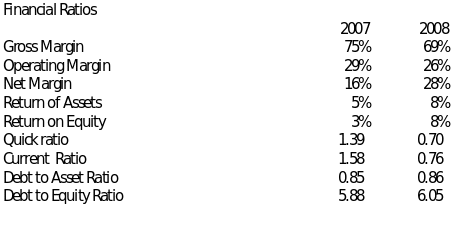
Future Prospects (10%)
This part analyses the company’s strengths and weaknesses as well any risks and opportunities that might affect the future prospects. Based on profitability from the past, the company may be predicted to increase its profitability within the said level. Its liquidity is also expected to be maintained also within the acceptable level since its profitability would cause its liquidity. Based on the forecasted profitability performance and liquidity level, there is reasonable basis to make an investment with the company’s stocks (Ross et. al, 1996; Van Horne, 1992).
The profitable operation in terms of return on assets and return on equity and positive profit makes up for the company strength while its declined liquidity in 2008 may be considered as weakness. The risks that company faces include, among others, changes in laws and its possible breaches of health and environmental laws which could affect is business as the company is heavily regulated in many of its business. It opportunities include its ownership of complementary businesses in UK and US which could provide growth and value to the company over the long-term (National Grid, 2009).
Predict and discuss the likely performance and liquidity position of the company in the year following that which you have examined in your answers to parts (a) and (b)
The company’s likely performance and liquidity position of the company for the future may be based on the historical past in 2007 and 2008. Since profit increase from 2007 to 2008, there is good reason to believe that there could still be profitability in the following year. As far as liquidation is concerned, it could be asserted that liquidity could be more a function of profitability since funds could normally come from operations.
State, with reasons, whether or not you would consider the company to be a wise investment target. (10%)
This researcher considers National Grid to be a possible option for investment due to good profitability but could not be easily categorized as wise investment target because of its sudden decline in its liquidity position which appears to put the company in danger if it could not meet its currently maturing obligation. It debt to equity ratio that would show it long-term capital position also deteriorated in 2008 from 2007. Thus a careful attitude to should be made if an investment should be made to the company. If liquidity could be improved by the company, there could be good reason to make investment in the company’s stocks.
Reliability Of Financial Information (15%)
This part discusses agency, attribution and signalling theory as a way to explain the reliability of financial information by citing examples as taken from the annual financial report of National Grid. The role of the auditor in ensuring the reliability of information in the Operating and Financial Review and Chairman’s Statement from National Grid will also form part of this section. On the latter subsections this part will explain reasons for unreliability of statements made in Business Review and those of the Chairman and about voluntary publication of certain aspects of its activities by National Grid.
Agency theory assumes that managers would do things that would serve their personal interest above the stockholders of whose interest they should serve. This could be related to the tendency not to impress that management is doing well for the company by telling stockholders that company is stable and producing as expected. This could be influenced in terms of Return on Assets (Meigs and Meigs, 1995).
Attribution theory may explain the cause of behaviour from others (Martinko, M., et al,1995). These causes could be either external or internal factors. In the case of the company’s management meeting the need to present reliable financial statements, this may refer to validity of external and internal events that could explain the characteristics of financial information. To apply since external events in the economy could offer consistency in the financial results from 2008 and 2007 for National Grid, the company’s financial statement may assert some degree of reliability.
Signalling theory may refer to some acts of the management that would reinforce or deny what the financial reports of the company may mean to inform the public. Examples of signalling from the financial statements include the conservative accounting policies, voluntary disclosure and earnings forecast and audit quality as found in the case of National Grid (2009). The audit’s report therefore lends credibility to reliability of the financial statements as way to counterbalance the bias of management (Whittington and Pany, 1994).
Explain why the information provided in the Business Review (formerly the Operating and Financial Review) and Chairman’s Statement may be unreliable and the role of the auditor in assessing this information.
The Business Review and Chairman’s Statement may be unreliable since the statement is made from a bias person like the Chairman and the company’s management because the Chairman may be presumed to be a bias person as far as the company is concerned. It is basic principle in evidence that person would not normally tell things against oneself except it is true. Normally therefore, a person (either juridical or natural) telling something about his interest (or the company’s interest) would normally make self-serving statements. In other words, most probably, the chairman would make positive statements about the company and hence as much as possible negative news about the company will be kept at a minimum. The same principle may be asserted in the case of what is provided by the Business Review which is made by the management of National Grid.
Why might the company wish to voluntarily publicise certain aspects of its activities? Outline the relevant underlying theories and give an example of each from the company of your choice. (15%)
The company wishes to voluntarily publicize certain aspects of its activities principally on two reasons. As required by the accounting standards, the company needs to make disclosure to inform its current investors on what is happening in the company on whether profits are being earned, the needed liquidity is being maintained and other information that it IFRS requires to be made as use earnings per share and outstanding shares of stock at given fiscal or calendar year whichever is applicable to a company. This could be seen in the case of National Grid which has made the mentioned information available to users in its 2008 Annual Report. The relevant underlying theories for making some information public include the theory of adequate disclosure under IFRS (Mirza, A., 2005).
The other reason why companies certain aspect of its business is advertise the company to investors and the public. This could be seen in the case of National Grid making known it plans for the future. This would have the way of informing the investors about the prospects faced by the company.
Conclusion
It can be concluded that National Grid is profitable but with decreased liquid in 2007 on the basis of analysis made. Based on future prospects made which also made use of past profitability and liquidity performance, this paper finds a reasonable ground to recommend taking a careful attitude in considering buying stocks of the company as an investment target. While profitability could generate sufficient cash flow to sustain certain liquidity level and would assure investors of claims for dividends or in terms even higher stock prices, it capacity may be limited by the amount of big long-term debt becoming current liability in an instant as what happened in the case of National Grid.
As far as reliability of financial statements is concerned, that of National Grid could be given the presumption of reliability. Although statements made the Chairman and those that are made in the Business may presumably be bias in favour of the company, there are external factors that could confirm under the attribution theory on why the results and liquidity position of the company should be believed.
References
Bernstein, J. (1993) Financial Statement Analysis, IRWIN, Sydney, Australia.
Brigham, E. and Houston, J. (2002) Fundamentals of Financial Management, Thomson South-Western, London, UK.
Droms (1990) Finance and Accounting for Non Financial Managers, Addison-Wesley Publishing Company, England.
Helfert, E. (1994), Techniques for Financial Analysis, IRWIN, Sydney, Australia.
Martinko, M., et al (1995) Attribution Theory: An Organizational Perspective, CRC Press.
Meigs, R,. Meigs, W., & Meigs, M. (1995), Financial Accounting, McGraw-Hill, New York, USA.
Mirza, A. (2005), International Financial Reporting Standards (IFRS) Workbook: Standard Outlines, Multiple-choice Questions and Case Studies with Solutions; John Wiley and Sons.
MSN (2009) Corporate Report of National Grid. Web.
National Grid (2009) Annual Report and Accounts, 2007/2008. Web.
New York Times (2009), British-Based Utility Is Buying KeySpan. Web.
Ross et. al (1996) Essentials of Corporate Finance ,IRWIN, London, UK.
Van Horne, J.C. (1992), Financial Management Policy, Prentice-Hall, Inc., London, UK.
Whittington & Pany (1995) Principles of Auditing , IRWIN, London, UK.
Appendices
Appendix A
2007/2008 Annual Report of National Grid, Please down load the same using. Web.
Appendix B
A Table Showing the Calculation of Any Ratios Used in the Assignment.
